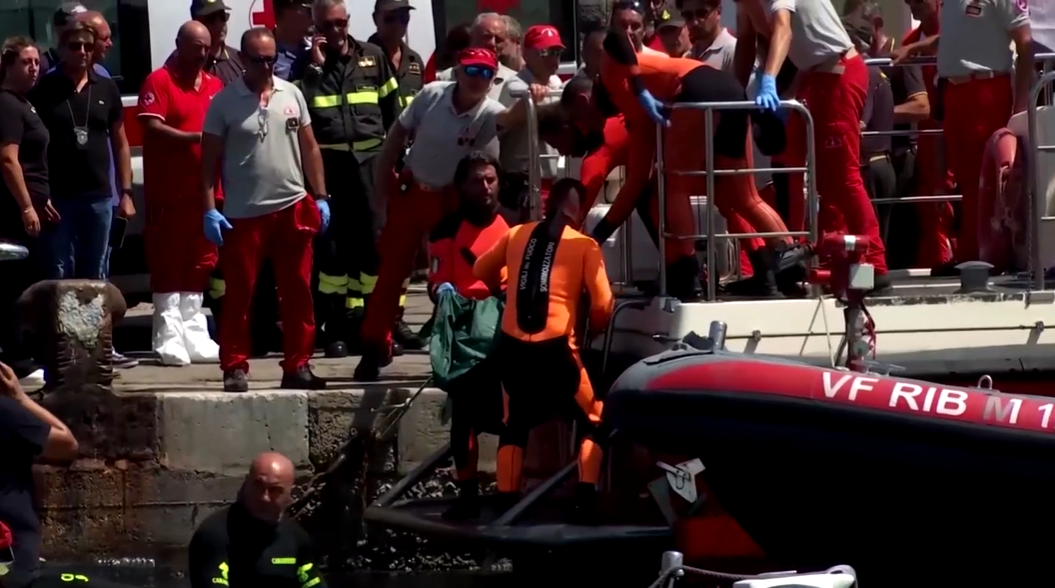Travel
Superyacht Tragedy in Sicily: A Comprehensive Analysis of the Incident and Its Aftermath

The Mediterranean Sea, often a symbol of luxury and tranquility, became the backdrop for a devastating maritime disaster off the coast of Sicily in August 2024. A superyacht, owned by billionaire Bernard Arnault, carrying several high-profile individuals, capsized and sank under mysterious circumstances, leading to a tragic loss of life. After days of intense search and rescue operations, the body of the final missing person was recovered, bringing a somber closure to an event that has captured international headlines and sparked widespread concern.
This report gives an analysis of the superyacht tragedy in Sicily, examining the events leading up to the disaster, the rescue efforts, the implications for maritime safety, and the broader impact on the global yachting community.
The Superyacht: A Symbol of Wealth and Prestige
Superyachts, often seen as the ultimate symbol of wealth and luxury, are large, privately-owned vessels equipped with the most advanced technology and amenities. These vessels are commonly associated with the world’s elite, including celebrities, business magnates, and royals, who use them for leisure and travel across the world’s most exclusive waters.
The superyacht involved in this tragedy was no exception. Measuring over 150 feet in length, the vessel was a masterpiece of modern engineering, featuring state-of-the-art navigation systems, luxurious interiors, and the capability to navigate the open seas with ease. It was registered under the flag of a European country known for its lenient maritime regulations, a common practice among superyacht owners to avoid stringent legal obligations.
The yacht was reportedly carrying a group of wealthy and influential individuals, including a prominent businessman, his family members, and several guests, all of whom were looking forward to a peaceful summer voyage in the Mediterranean. The trip, however, ended in catastrophe, raising serious questions about the safety standards and regulatory oversight in the superyacht industry.
The Tragic Event: What Happened?
On the evening of August 17, 2024, the superyacht was navigating through the waters off the northern coast of Sicily, near the Aeolian Islands, a region known for its beautiful but sometimes treacherous seas. According to initial reports, the weather was relatively calm, and there were no warnings of any severe conditions that could have posed a threat to the vessel.
However, at approximately 10:30 PM local time, the yacht suddenly began to list heavily to one side. Despite the efforts of the crew to stabilize the vessel, it quickly became clear that something was seriously wrong. Within minutes, the yacht capsized and began to sink, throwing passengers and crew members into the dark waters.
Emergency distress signals were sent out, and nearby vessels, along with the Italian Coast Guard, were immediately dispatched to the scene. The rescue operation, hampered by the darkness and the rapidly deteriorating situation, managed to save several individuals who were found clinging to debris or struggling in the water. Tragically, a number of passengers and crew were unaccounted for, prompting an extensive search operation that continued for several days.
Search and Rescue Operations
The search and rescue operation was one of the largest conducted in the region in recent years, involving multiple agencies, including the Italian Coast Guard, local authorities, and private vessels. The search area was expansive, covering several nautical miles around the site of the wreckage. Helicopters, drones, and underwater sonar equipment were deployed to assist in the search, with divers combing the depths where the yacht had sunk.
Over the course of several days, the bodies of the missing individuals were gradually recovered, each discovery bringing heartbreak to the families and friends awaiting news. The final body, that of a high-profile businessman who was believed to be one of the last individuals to go down with the yacht, was recovered on August 23, 2024. The recovery of this last victim brought a somber conclusion to the search efforts, allowing the focus to shift to understanding what had caused such a devastating incident.
Investigating the Causes
With the search and rescue operations concluded, the focus turned to investigating the causes of the tragedy. Given the size and sophistication of the superyacht, and the absence of any immediate environmental threats, the incident raised many questions about what could have gone wrong.
Initial reports from survivors and rescuers suggested that the yacht may have experienced a sudden mechanical failure or a structural issue that led to the rapid sinking. The vessel’s list, which occurred without warning, indicated that a critical failure may have compromised the yacht’s stability, leading to the catastrophic event.
Potential Causes of the Disaster
1. Mechanical Failure: One theory is that a mechanical failure, such as a malfunction in the ballast system, could have caused the yacht to list and eventually capsize. The ballast system, which helps maintain the yacht’s balance by controlling the distribution of water within the hull, is critical to the vessel’s stability. If this system were to fail, it could cause the yacht to tip uncontrollably, especially if the crew was unable to correct the problem in time.
2. Structural Compromise: Another possible cause being explored is a structural compromise. Superyachts, despite their luxurious appearance, are complex machines subject to significant stress, particularly in rough seas. If a critical component of the yacht’s structure, such as the hull or superstructure, was compromised, it could have led to the rapid flooding and sinking of the vessel.
3. Human Error: Human error is also being considered as a potential contributing factor. The superyacht was reportedly being operated by an experienced crew, but even seasoned professionals can make mistakes under pressure. An incorrect maneuver, miscommunication among the crew, or a delayed response to an emergency could have exacerbated the situation, leading to the tragic outcome.
4. Weather Conditions: Although initial reports indicated calm weather, investigators are not ruling out the possibility that sudden and unexpected changes in weather conditions may have played a role. The Mediterranean Sea, while generally predictable, can experience sudden shifts in wind and wave patterns, particularly around the Aeolian Islands, which could have caught the crew off guard.
Regulatory Oversight and Industry Practices
The superyacht industry, while glamorous and prestigious, operates under a patchwork of regulations that vary significantly depending on the vessel’s flag state. Many superyacht owners register their vessels in countries known for their lenient maritime laws, which can lead to inconsistencies in safety standards and enforcement.
1. Flag of Convenience: The practice of registering vessels under a “flag of convenience” is common in the superyacht industry. This allows owners to benefit from lower taxes, fewer regulations, and greater privacy. However, it also means that the yacht may not be subject to the same rigorous safety inspections and standards as those registered under more stringent jurisdictions. In the case of the Sicilian tragedy, investigators are examining whether the flag state’s regulations were sufficiently robust to prevent such an incident.
2. Safety Standards: The tragedy has prompted renewed scrutiny of the safety standards in the superyacht industry. While these vessels are equipped with advanced technology and are subject to safety certifications, there are concerns that the existing regulations may not be adequate to address the unique challenges of operating such large and complex vessels. The investigation into the Sicilian disaster may lead to calls for stricter safety standards and more consistent enforcement across the industry.
3. Crew Training: Another area of concern is the training and qualifications of superyacht crews. Operating a superyacht requires specialized skills and knowledge, particularly in emergency situations. The crew’s response to the disaster will be closely examined to determine whether they were adequately prepared and trained to handle the crisis. If deficiencies are found, it could lead to changes in the training requirements for superyacht crews.
The Impact on the Global Yachting Community
The tragedy off the coast of Sicily has sent shockwaves through the global yachting community, which is grappling with the implications of such a high-profile disaster. Superyacht owners, operators, and industry professionals are all keenly aware of the potential consequences for the industry’s reputation and regulatory environment.
1. Reputational Damage: The superyacht industry, often seen as an enclave of luxury and exclusivity, is facing a reputational challenge in the wake of the Sicilian disaster. The incident has highlighted the potential risks associated with superyachting, particularly when it comes to safety and regulatory oversight. This could lead to increased scrutiny from the public and policymakers, potentially resulting in tighter regulations and more rigorous safety standards.
2. Insurance and Liability: The financial implications of the disaster are also significant. Superyachts are insured for substantial sums, often running into tens of millions of dollars. The insurers involved will be conducting their own investigations to determine the cause of the incident and assess liability. The outcome of these investigations could impact insurance premiums and coverage terms for other superyacht owners, as well as lead to legal disputes over compensation.
3. Industry Reforms: In the longer term, the Sicilian tragedy may serve as a catalyst for reforms within the superyacht industry. Industry groups, regulators, and insurers may push for changes in how superyachts are constructed, operated, and maintained. This could include the introduction of new safety technologies, stricter certification processes, and enhanced crew training programs. Such reforms would aim to prevent similar tragedies from occurring in the future and restore confidence in the industry.
The Human Cost: Remembering the Victims
While much of the focus has been on the technical and regulatory aspects of the disaster, it is important to remember the human cost of the tragedy. The victims included a prominent businessman, his family members, and several other individuals who were guests on the yacht. Their loss has been deeply felt by their families, friends, and the communities to which they belonged.
1. The Families’ Grief: For the families of the victims, the recovery of the final missing body brings a painful sense of closure. The grieving process is made even more difficult by the public nature of the tragedy, as they must navigate their loss under the spotlight of international media attention. Support from loved ones, grief counselors, and community members will be crucial in helping them cope with their loss.
2. Memorial Services: Memorial services for the victims are being planned in their respective home countries, where they will be remembered for their contributions to their communities and the lives they touched. These services will provide an opportunity for friends and family to come together to mourn and honor the memories of those who were lost in the tragedy.
Conclusion
The superyacht tragedy off the coast of Sicily is a stark reminder of the potential risks that even the most luxurious and sophisticated vessels face on the open seas. As the investigation into the disaster continues, questions about the causes of the incident, the adequacy of regulatory oversight, and the preparedness of the crew will need to be answered. The outcome of these investigations could lead to significant changes in the superyacht industry, aimed at preventing similar tragedies in the future.
While the recovery of the final missing body brings a degree of closure, the loss of life in such a tragic and unexpected manner leaves a lasting impact on all those affected. The global yachting community, regulators, and industry professionals must now reflect on the lessons learned from this disaster and work together to ensure that the safety and well-being of all those who venture out to sea remain a top priority.
-

 Automotive7 days ago
Automotive7 days agoUnlocking Performance: Why the HP Spectre x360 is the Ultimate 2-in-1 Laptop for 2025
-

 Education7 days ago
Education7 days agoHow to Easily Access Your Courses: A Step-by-Step Guide to Coursera Login
-

 Cryptocurrency7 days ago
Cryptocurrency7 days agoWhich Crypto to Buy Today for Short-Term Gains: Your May 2025 Guide
-

 Gadgets & Electronics6 days ago
Gadgets & Electronics6 days agoComprehensive Acer Chromebook Laptop Reviews: Unveiling the Best Models of 2025
-

 Business7 days ago
Business7 days agoDiscover the Best Laptop for Working from Home in 2025: Top Picks and Reviews
-

 Business7 days ago
Business7 days agoTop 5 Penny Stocks to Buy Now for Maximum Growth Potential in 2025
-

 Cryptocurrency6 days ago
Cryptocurrency6 days agoBlockchain Beyond Cryptocurrency: 5 Game-Changing Applications You Should Know
-

 Space7 days ago
Space7 days agoExperience the Universe: Tune into NASA Live for Real-Time Space Exploration


















